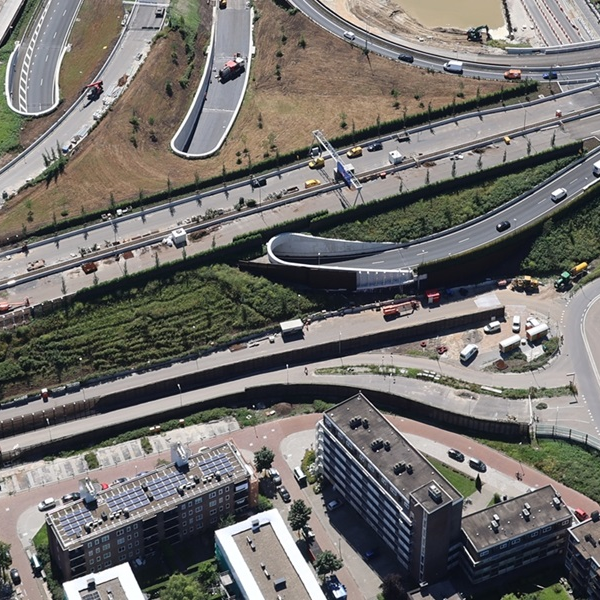Improvements to ring road increase traffic flow in Groningen

Improvements to ring road increase traffic flow in Groningen
On 1 September 2024, Groningen’s new and improved southern ring road was opened. As the city’s main entry point, this road had previously struggled with gridlock resulting from the city’s significant growth. Improvements to the twelve-kilometre-long ring road have now increased traffic flow, accessibility, road safety, and liveability.
Rijkswaterstaat awarded this assignment to Combinatie Herepoort, a collaboration that Witteveen+Bos has been a part of since the tender phase in 2015. We were responsible for designs and provided advice (e.g. on the design of the road network and various structures), noise analyses, and environmental cost indications. Ultimately, more than 225 Witteveen+Bos colleagues worked on this project.
Julianaplein
One of the project’s biggest challenges was how to approach the Julianaplein motorway junction. The A7 and N7 motorways meet here, originally at a single-level intersection. After seven years of hard work on reconstructing the ring road, the intersection at Julianaplein has been removed (as has the one at Vrijheidsplein).
Between Julianaplein and the Europaweg road, the southern ring road was sunken, removing it from view. Traffic from every direction now flows better, improving the accessibility of both the city and the region.
On the west side of Julianaplein, a movable bridge over the Noord-Willemskanaal waterway regularly caused delays, as traffic had to wait for ships to pass. A new fixed bridge has now eliminated these delays.

Vrijheidsplein and the western ring road
To get on to Groningen’s western ring road, traffic previously had to give way to vehicles in the roundabout at Vrijheidsplein. This caused significant congestion. This junction is now a grade-separated crossing which allows traffic from Drachten and the southern ring to easily enter the western ring road (and vice versa).
The number of lanes between Vrijheidsplein and the village of Hoogkerk has also been increased. Traffic exiting the city towards Hoogkerk now does so using three lanes instead of two. Traffic on the western ring is also no longer held up by traffic lights at Martiniplaza. By raising the ring road here, the need for a junction with Concourslaan and Leonard Springerlaan was eliminated.
Liveability
In some places, the southern ring road was not just sunken but channelled entirely underground. This created space for a new city park: Zuiderplantsoen. Between the Hereweg street and the Oude Winschoterdiep waterway, the sunken ring road becomes a tunnel for about 1,100 metres. Above this tunnel, different parts of the city are connected via Zuiderplantsoen.
The existing Sterrebos park, which was cut in two in the 1960s by the construction of the southern ring road, has been made whole again by the Zuiderplantsoen, enhancing liveability in this part of the city.
In the past, traffic on the east side of the southern ring road was also regularly congested. For this reason, the Europaplein junction was rebuilt, separating the different streams of traffic. This has improved traffic flow and made the Eemspoort and Driebond business parks more accessible.
Helperzoom Tunnel
Linking the Helpman and Europapark districts, the Helperzoom Tunnel was constructed under the railway line. It replaces a railway crossing that had to be closed in line with safety requirements. Construction of the tunnel started in 2017.
The completed tunnel was placed on tracks and moved into place within three hours in August 2019. The tunnel’s opening in April 2020 ensured a safe connection for cars, bikes, buses and emergency services between the Helpman and Coendersborg residential areas and the east side of the railway line.
More information?
